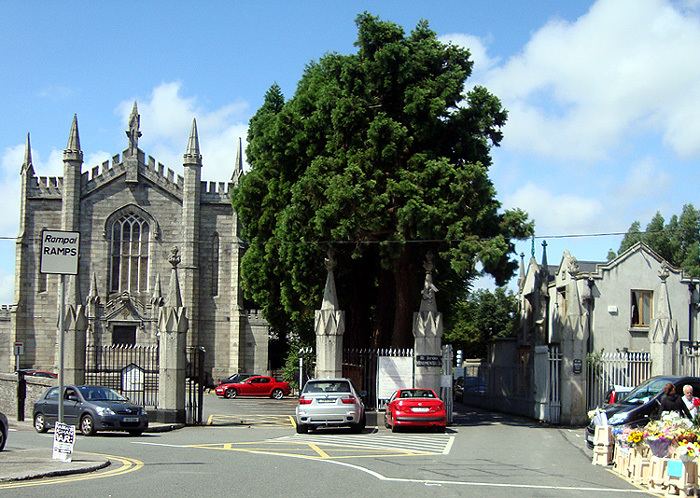Mount Jerome Cemetery & Crematorium (Irish: Reilig Chnoc Ieróim) is situated in Harold's Cross on the south side of Dublin, Ireland. Since its foundation in 1836, it has witnessed over 300,000 burials. Originally an exclusively Protestant cemetery, Roman Catholics have also been buried there since the 1920s.
The name of the cemetery comes from an estate established there by the Reverend Stephen Jerome, who in 1639 was vicar of St. Kevin's Parish. At that time, Harold's Cross was part of St. Kevin's Parish. In the latter half of the 17th century, the land passed into the ownership of the Earl of Meath, who in turn leased plots to prominent Dublin families. A house, Mount Jerome House, was constructed in one of these plots, and leased to John Keogh. In 1834, after an aborted attempt to set up a cemetery in the Phoenix Park, the General Cemetery Company of Dublin bought the Mount Jerome property, "for establishing a general cemetery in the neighbourhood of the city of Dublin".
The Funerary Chapel in the cemetery was the first Puginian Gothic church in Dublin. It was designed by William Atkins.
In 2000, Mount Jerome Cemetery established its own crematorium on the site.
Notable people buried here include:
Robert Adams (1791–1875), physician and professor of surgeryMaeve Binchy (1940–2012), author (cremated)Edward Bunting (1773–1843), musician, music-collectorFrederick William Burton (1816–1900), painter and director of the National GalleryPeter Caffrey (1949–2008), actor (cremated) (Ballykissangel)Sir Charles Cameron (1830–1921), for 50 years head of the Public Health Department of Dublin Corporation, along with two of his sons, Charles J. and Ewen HenryJames Campbell, 1st Baron Glenavy (1851–1931), lawyer, politician and Lord Chancellor of IrelandWilliam Carleton (1794–1869), writerThomas Caulfield Irwin (1823–1892), poet, writer, scholarAbraham Colles (1773–1843), surgeon, professor of medicineJohn Augustus Conolly VC (1829–1888), soldierMichael Colivet (1882–1955), Irish politician, Commandant of the Irish Volunteers for Limerick City, a founding member of the Irish Republic and, in later years, Chairman of the National Housing Board.Paddy Daly (1888–1957), member of the IRA during the War of Independence and later Major-General in the Irish ArmyAchilles Daunt (1832–1878), preacher and homilistDerek Davis (1948–2015), broadcasterThomas Davis, (1814–1845), journalist, politician, founder of The Nation newspaperThomas Drummond (1797–1840), surveyor, Under-Secretary for IrelandProf George Francis Fitzgerald (1851-1901), physicistJames Fitzgerald (1899–1971), American painterEthel Kathleen French (née Moore, 1871–1891), artist and illustrator, first wife of Percy French. She died in childbirth with their first child.Edward Gibson, 1st Baron Ashbourne (1837–1913), lawyer and Lord Chancellor of IrelandRobert Graves (1796–1853), professor of medicine and writerSir Richard John Griffith (1784–1878), geologist, mining engineer, chairman of the Board of Works, author of Griffith's ValuationThomas Grubb (1800–1878), optician, telescope-makerBenjamin Guinness (1798–1868), brewer, philanthropist, and other members of the Guinness familyGeorge Halpin (Sr.) (1779–1854), civil engineer and lighthouse builderWilliam Rowan Hamilton (1805–1865), mathematician and astronomerJames Haughton (1795–1873), social reformerJohn Kells Ingram (1823–1907), politician, scholar, poet ("The Memory of the Dead")John Hewitt Jellett (1817–1888), Provost of Trinity CollegeJohn Edward Jones (1806–1862), civil engineer and sculptorDavid Kelly (1929–2012), actor (cremated)Joseph Robinson Kirk (1821–1894), sculptor, who also executed the figure over the memorial of his father, ThomasThomas Kirk (1781–1845), sculptor, who also designed the Butler mausoleum in this cemeteryJohn Mitchell Kemble, scholarJoseph Sheridan Le Fanu (1814–1873), writer and editor, along with his wife, Susanna Bennett, her father and two brothers, in the same vault.Thomas Hawkesworth Ledwich (1823–1858), surgeon and anatomistThomas Langlois Lefroy (1776–1869), politician and judgeJan Lukasiewicz (1878–1956), Polish philosopher and logicianDavid Marcus (1924–2009), Irish Jewish writer, editorSir Henry Marsh (1770–1860), physicianWilliam Fetherstone Montgomery (1797–1859), obstetricanHans Garrett Moore VC (1830–1889), soldierArthur Thomas Moore VC (1830–1912), soldierSir Richard Morrison (1767–1849), architect (Pro-Cathedral, Trinity College, etc.)William Vitruvius Morrison (1794–1838), architect; son and partner of Richard Morrison.John Skipton Mulvany (1813–1870), architect who also designed a number of monuments in this cemetery, including the Mahony monument and Perry and West vaultsMáirtín Ó Cadhain (1906–1970), Irish-language writerMáirtín Ó Direáin, (1910–1988), Irish-language poet.Walter Osborne (1859–1903), artistPeter Marshall (died 1890), prominent member of the Masonic and Orange OrdersWilliam McFadden Orr (1866–1934), mathematicianGeorge Papworth (1781–1855), architectJacob Owen (1778–1870), architect and engineer to the Board of WorksEdward Arthur Henry Pakenham, 6th Earl of Longford (1902–1961) was an Irish peer, politician, and littérateurGeorge Petrie (1790–1886), artist, archaeologist, musicianWilliam Plunket, 4th Baron Plunket (1828–1897), Archbishop of DublinSarah Purser (1848–1943), artistGeorge Russell (1867–1935), writer, artistCecil Sheridan (1910–1980), comedian and actorJohn Skelton (1924–2009), artist and illustrator.Ellen Smyly (1815–1901) founder of the Smyly Homes.Robert William Smith (1807–1873), pathologistBindon Blood Stoney (1828–1909), engineer.John Millington Synge (1871–1909), playwrightIsaac Weld (1774–1856), topographical writer, explorer and artist.William Wilde, father of Oscar Wilde. His wife, Jane Francesca Elgee, is commemorated on Sir William's monument, but she was buried in Kensal Green Cemetery in London.S. Allen Windle (1828–1880), Chaplain of the Mariners' Church, Dún LaoghaireEdward Perceval Wright (1834–1910), ophthalmic surgeon, botanist and zoologistJack Butler Yeats (1871–1957), artistThere is a large plot to the deceased members of the Royal Irish Constabulary and the Dublin Metropolitan Police.
The cemetery contains the war graves of 35 British Commonwealth service personnel from World War I and 39 from World War II.
The remains of French Huguenots from St. Peter's Churchyard, Peter's Row (now the location of the Dublin YMCA), which was demolished in the 1980s, and from St. Brigid's and St. Thomas's churchyards are interred in the cemetery.
Over 200 children of unmarried mothers who died in the Protestant run Bethany Home were buried in unmarked graves in the cemetery. There is a plot where unnamed children from Kirwan House the Protestant run Female Orphan Home are buried.
Recent burials include the notorious Martin Cahill (1949–1994) (known as "The General"). His gravestone has been vandalised on numerous occasions and is currently broken in two with the top half missing. His body has since been removed to an unmarked grave in the cemetery.
The cemetery has one of only two Christ-thorn bushes in Ireland (the other is in the Botanic Gardens).

